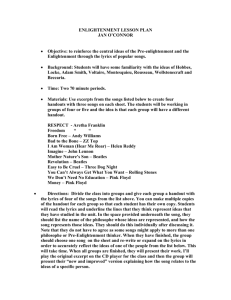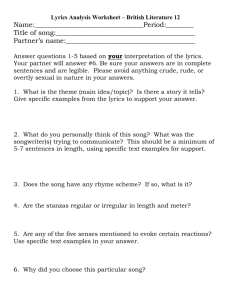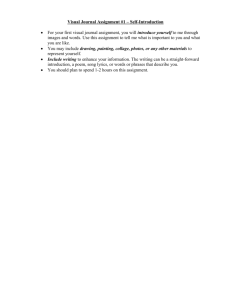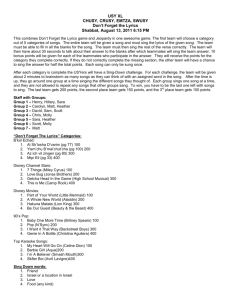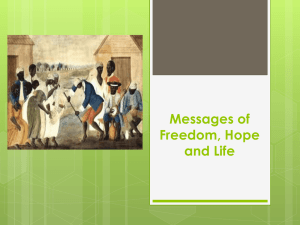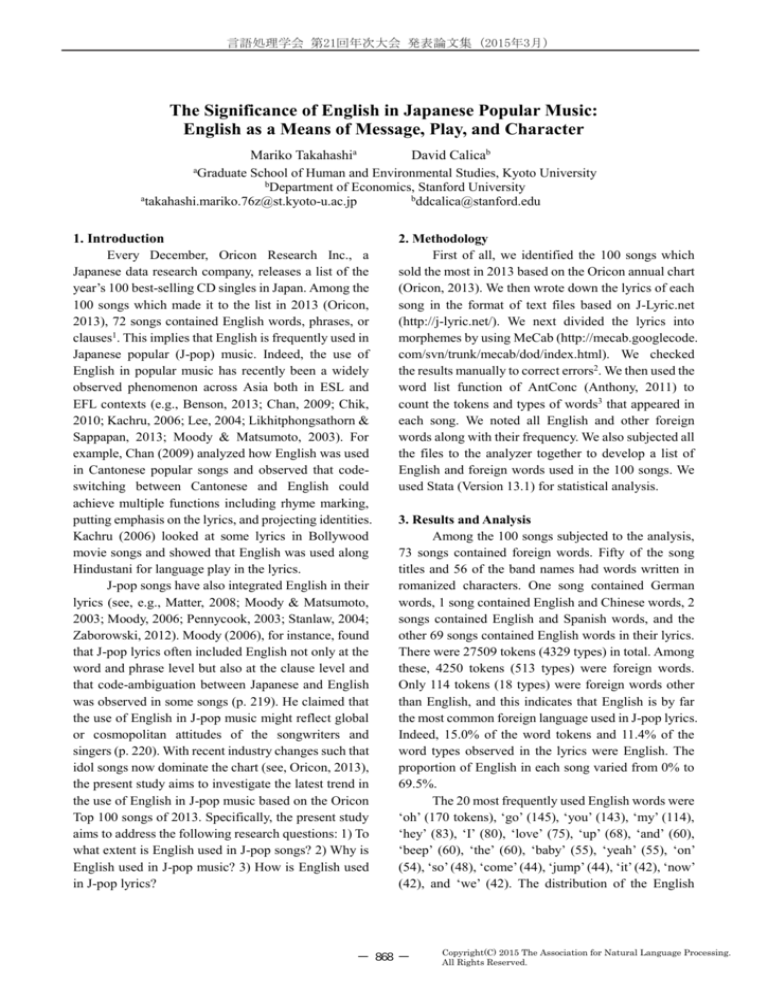
言語処理学会 第21回年次大会 発表論文集 (2015年3月)
The Significance of English in Japanese Popular Music:
English as a Means of Message, Play, and Character
David Calicab
Mariko Takahashia
a
Graduate School of Human and Environmental Studies, Kyoto University
b
Department of Economics, Stanford University
a
b
takahashi.mariko.76z@st.kyoto-u.ac.jp
ddcalica@stanford.edu
1. Introduction
Every December, Oricon Research Inc., a
Japanese data research company, releases a list of the
year’s 100 best-selling CD singles in Japan. Among the
100 songs which made it to the list in 2013 (Oricon,
2013), 72 songs contained English words, phrases, or
clauses1. This implies that English is frequently used in
Japanese popular (J-pop) music. Indeed, the use of
English in popular music has recently been a widely
observed phenomenon across Asia both in ESL and
EFL contexts (e.g., Benson, 2013; Chan, 2009; Chik,
2010; Kachru, 2006; Lee, 2004; Likhitphongsathorn &
Sappapan, 2013; Moody & Matsumoto, 2003). For
example, Chan (2009) analyzed how English was used
in Cantonese popular songs and observed that codeswitching between Cantonese and English could
achieve multiple functions including rhyme marking,
putting emphasis on the lyrics, and projecting identities.
Kachru (2006) looked at some lyrics in Bollywood
movie songs and showed that English was used along
Hindustani for language play in the lyrics.
J-pop songs have also integrated English in their
lyrics (see, e.g., Matter, 2008; Moody & Matsumoto,
2003; Moody, 2006; Pennycook, 2003; Stanlaw, 2004;
Zaborowski, 2012). Moody (2006), for instance, found
that J-pop lyrics often included English not only at the
word and phrase level but also at the clause level and
that code-ambiguation between Japanese and English
was observed in some songs (p. 219). He claimed that
the use of English in J-pop music might reflect global
or cosmopolitan attitudes of the songwriters and
singers (p. 220). With recent industry changes such that
idol songs now dominate the chart (see, Oricon, 2013),
the present study aims to investigate the latest trend in
the use of English in J-pop music based on the Oricon
Top 100 songs of 2013. Specifically, the present study
aims to address the following research questions: 1) To
what extent is English used in J-pop songs? 2) Why is
English used in J-pop music? 3) How is English used
in J-pop lyrics?
2. Methodology
First of all, we identified the 100 songs which
sold the most in 2013 based on the Oricon annual chart
(Oricon, 2013). We then wrote down the lyrics of each
song in the format of text files based on J-Lyric.net
(http://j-lyric.net/). We next divided the lyrics into
morphemes by using MeCab (http://mecab.googlecode.
com/svn/trunk/mecab/dod/index.html). We checked
the results manually to correct errors2. We then used the
word list function of AntConc (Anthony, 2011) to
count the tokens and types of words3 that appeared in
each song. We noted all English and other foreign
words along with their frequency. We also subjected all
the files to the analyzer together to develop a list of
English and foreign words used in the 100 songs. We
used Stata (Version 13.1) for statistical analysis.
3. Results and Analysis
Among the 100 songs subjected to the analysis,
73 songs contained foreign words. Fifty of the song
titles and 56 of the band names had words written in
romanized characters. One song contained German
words, 1 song contained English and Chinese words, 2
songs contained English and Spanish words, and the
other 69 songs contained English words in their lyrics.
There were 27509 tokens (4329 types) in total. Among
these, 4250 tokens (513 types) were foreign words.
Only 114 tokens (18 types) were foreign words other
than English, and this indicates that English is by far
the most common foreign language used in J-pop lyrics.
Indeed, 15.0% of the word tokens and 11.4% of the
word types observed in the lyrics were English. The
proportion of English in each song varied from 0% to
69.5%.
The 20 most frequently used English words were
‘oh’ (170 tokens), ‘go’ (145), ‘you’ (143), ‘my’ (114),
‘hey’ (83), ‘I’ (80), ‘love’ (75), ‘up’ (68), ‘and’ (60),
‘beep’ (60), ‘the’ (60), ‘baby’ (55), ‘yeah’ (55), ‘on’
(54), ‘so’ (48), ‘come’ (44), ‘jump’ (44), ‘it’ (42), ‘now’
(42), and ‘we’ (42). The distribution of the English
― 868 ―
Copyright(C) 2015 The Association for Natural Language Processing.
All Rights Reserved. words approximated a Zipf distribution. Fifty-eight
songs contained English phrases or clauses, while 14
songs only contained independent English words.
There were seven songs with more than 50% of the
lyrics written in English4: HEY WHAT’S UP by Jin
Akanishi (69.5%), HOT SHOT by GENERATIONS
from EXILE TRIBE (60.2%), SURVIVORS feat.DJ
MAKIDAI from EXILE by THE SECOND from EXILE
(55.9%), Boys Meet U by SHINee (55.7%), WINNER
by Choshinsei (54.8%), BURING UP by EXILE TRIBE
(53.1%), and No Limit by EXILE (50.3%). This seems
to indicate that some singers include English in their
lyrics more frequently than other singers. In order to
see if gender of the performer plays a role in using
English, we tested the frequency of English words
based on the performer's gender.
Of the top 100 singles, 62 were performed by
male singers as leads. Using an ordinary least squares
linear regression analysis, with gender as an indicator
variable, male-performed songs were found to use
significantly more English. A male-led song on average
had 51.8 more English tokens than a female-led song
(p<.01). Indeed, all of the songs with more than 50%
of the lyrics written in English were performed by male
singers. Also, female performers were significantly
more likely not to use English words. 42.1% of the
female songs did not use any English, while 19.4% of
the male songs did not use any English (p<.05).
After separating the albums into male and female
groups, the regression was then run to determine the
correlation between English usage and performer age.
Age was defined as the age upon the single’s official
release. In the case of groups, the performers’ ages
were averaged. Female performers were on average 7.8
years younger than their male counterparts. The
average age of the top 100 female performers was 21.2.
The average age of the top male performers was 29.0.
For female performers, there was no significant
correlation between age and English usage. However,
for male performers, there was a small significant
correlation, where older male performers used fewer
English tokens. A 10 year age difference was correlated
with having 30.5 fewer English tokens in the song
(p<.01).
There were 45 songs whose lyrics contained
English clauses, or sentences. However, all the
sentences were simple sentences as in “I’m standing
here now and forever” and (EXILE PRIDE~Konna
Sekai o Aisurutame~ by EXILE) “You’re so cool!”
(Kamonegix by NMB48). Compound and complex
sentences were not observed in the data. This indicates
that J-pop lyrics do not have complicated English
structures in them. Instead, they tend to use structures
that can be easily understood by a general audience.
English phrases and clauses in the lyrics tended to be
grammatical.
Besides pronouns and fillers, verbs of motion
(e.g., go, jump, dance, come, get), romance related
words (e.g., love, like, baby, girl, believe, heart), a
variety of descriptive adjectives (e.g., hot, happy, sweet,
merry, crazy) were also frequently observed. This
indicates that English is actually used to express
feelings and emotions in J-pop music.
Some songs used English phrases and clauses
repetitively as in “Oh Baby, My angel […] Oh Baby,
My angel” (Heart Ereki by AKB48) and “Come On A
My House ‘Kare ga suki?’ (JUMP! JUMP!)/ Come On
A My House ‘Boku ga suki?’ (JUMP! JUMP!)” (Come
On A My House by Hey! Say! JUMP). This repetition
was also used as a rhyming scheme. There were songs
which used English for rhyming with Japanese as in
“Sansei kawaii! Sunshine furisosogu” (Sansei Kawaii!
by SKE48). Code ambiguation between English and
Japanese (see, e.g., Moody & Matsumoto, 2003) was
also observed. For example, “Kiss Your Mind” in KisMy-Ft2’s “Kiss Umai~ Kiss Your Mind” was
pronounced as “Kiss umai (good at kissing)” as the
song title shows. “Coming! Coming!” from the same
song was pronounced as “Kamu kamu (chew chew)”
probably because the song was written as an
advertisement song for a new line of chewing gums.
These examples indicate that English has a variety of
functions in J-pop songs.
4. Discussion
The results have shown that English is the most
frequently used foreign language in J-pop lyrics. Codeswitching and code-mixing are not commonly
observed phenomena in daily conversations in Japan
(Moody, 2006, p. 211). It is noteworthy then that more
than 70% of the analyzed songs contained English in
their lyrics. The actual proportion of English in each
song varied from 0% to 69.5%, and a diversity of
English words, phrases, and clauses were identified.
― 869 ―
Copyright(C) 2015 The Association for Natural Language Processing.
All Rights Reserved. Although certain types of words (i.e., verbs of motion,
romance related words, descriptive adjectives) were
frequently observed as analyzed above, the distribution
of English words used in the lyrics approximated to a
Zipf distribution. This implies that English is naturally
integrated in J-pop lyrics. Admittedly, the Oricon chart
does not necessarily represent all types of J-pop songs
released in Japan. However, the present study indicates
that there is an ongoing trend of integrating English in
J-pop music.
Some singers use English in their lyrics more
frequently than other singers, and male performers use
English significantly more frequently than female
performers. For female performers, age was not a
significant factor in using English in the lyrics. This
might imply that the performed image of youth and
cuteness matters more than the actual age although the
data put to the analysis tended to feature younger
female performers. Conversely, older male performers
did tend to use English somewhat less frequently than
younger male performers. As will be discussed below,
English in J-pop music is often associated with images,
such as being “modern” and “cool,” and this might be
a reason why younger male performers include English
more frequently in their lyrics compared to older
performers.
The use of simple structures enables the
audience to understand the English parts of the lyrics
relatively easily. In Japan, most people have at least six
years of experience of learning English. This means
that English is a foreign language which is supposed to
be understood at least to a certain extent by the
Japanese audience. In other words, English in J-pop
lyrics can fulfill the referential function (conveying
information and meaning), which is one of the two
essential functions of languages (see, Holmes, 2008).
This is likely to be one of the reasons why English is
the most preferred foreign language to use in J-pop
lyrics. As English is used across Asia (see, e.g., Benson,
2013), including English in the lyrics might attract
listeners from outside of Japan as well.
English in J-pop songs can also fulfill the
affective function (expressing how someone is feeling),
which is the other function of the two main functions
of languages (see, Holmes, 2008). In Japan, there is
“the intense fascination that is shown toward English”
(Seargeant, 2009, p.3). English is considered as a tool
for international communication, and English tends to
be socio-culturally associated with American culture
and British culture although this is not without
controversy.
In J-Pop songs, English is used to create a certain
image, such as a “modern,” “cool,” or “sophisticated”
image, to the song by using it symbolically or
indexically in association with American and British
cultures (see, e.g., Loveday, 1996; Lee, 2004). For
instance, the chorus part of “HOT SHOT” sung by the
youngest group of EXILE (GENERATIONS from
EXILE TRIBE) might be one of such examples: “HOT
SHOT/ Ready to Go! Tobashite iko/ Shippai o bane ni
shite aiming for the stars in space now come on!/ HOT
SHOT/ Ready to Go! Ue o mezaso/ We’re going up up
away and aratana sekai e.” Phrases, such as “hot shot,”
do not make sense literally and so must convey an
alternative meaning. “Hot shot” in particular appears to
emulate American slang in an attempt to create a cool
image. English is sometimes used also for intertextual
and mimetic purposes (e.g., Pennycook, 2003). For
instance, “Ladies and gentlemen boys and girls
everybody/ saiko no ima o/ Ladies and gentlemen boys
and girls everybody/ say oh oh oh oh” (HEY WHAT’S
UP by Jin Akanishi) seems to directly mimic American
popular music, and thus English here can project a
Western identity. In addition, some songs use English
to express feelings that sound too direct for Japanese
people if it were in Japanese (e.g., Stanlaw, 2004,
pp.104-105). Conveying feelings can sometimes be
more important than information, and thus, it is
essential for the languages used in J-pop lyrics to be
capable of performing this affective function as well.
As such, English is an ideal foreign language to use in
J-pop lyrics because it can play both referential and
affective functions.
As English fulfills these two functions, it can be
used for “language play” in the songs. According to
Beard (2007), “[h]aving fun, then, is integral to our
daily lives and sense of well-being, and playing with
language is an intrinsic part of that” (p. 84). In J-pop
music, for example, some songs use English to play
with the rhythm. The following lyrics alternate
Japanese and English in the chorus: “Dance My
Generation/ omae ni misetai no wa/ Dance My
Generation/ kakko tsuketa ore dake/ Dance My
Generation/ Sandoriyon o Tonight mitsuketa” (Dance
― 870 ―
Copyright(C) 2015 The Association for Natural Language Processing.
All Rights Reserved. My Generation by Golden Bomber). English here is
also used to make parts of the lyrics distinct. Repeating
English phrases and using English for rhyming, as
briefly shown above, are other strategies to create
rhythm patterns.
Another type of language play seen in J-pop
music is code ambiguation. Code ambiguation means
that parts of the lyrics are written in such a way as could
be interpreted both as Japanese and English (e.g.,
Moody & Matsumoto, 2003). An example of code
ambiguation was given above in Section 3. It is
different from giving special kana reading to Japanese
words written in kanji in the sense that the lyrics sound
both as English and Japanese.
5. Conclusion
This paper has shown that English is the most
commonly used foreign language in J-pop music.
Although English is a foreign language in Japan, 15.0%
of the words in the lyrics on average were English.
Performers are able to convey messages in English due
to the general knowledge of English by the Japanese
public. However, Japanese performers, especially
younger male performers, are also able to convey a
unique performative image through their use of English.
The diverse set of applications, including expression of
emotions, language play, and code ambiguation,
further emphasize the attractiveness of English for
Japanese performers. Admittedly, lyrics do not by
themselves project the whole image of the song. The
data analyzed in this study was also limited in the sense
that the Oricon Top 100 songs were dominated by idol
groups. However, the use of English is, and seems
likely to continue to be, a significant feature in J-pop
music.
Notes
1
In this study, we defined foreign words in the lyrics as
those written in romanized characters. In other words,
loan words written in katakana were not included.
2
Nearly 95% of the output by MeCab was correct. Most
errors were due to sentence fragments or unique use of
vocabulary due to the nature of lyrics.
3
In this paper, we regarded morphemes as equivalents to
words in order to count both independent words and
ancillary words.
4
See Oricon (2013) for the full discography.
Discography
Akanishi, J. (2013). HEY WHAT’S UP. Warner Music
Japan.
AKB48. (2013). Heart Ereki. You, Be Cool!/KING RECORDS
EXILE. (2013). EXILE PRIDE ~Konna Sekai o
Aisurutame~. rhythm zone.
GENERATIONS from EXILE TRIBE. (2013). HOT
SHOT. rhythm zone.
Golden Bomber (2013). Dance My Generation. Zany Zap.
Kis-My-Ft2. (2013). Kiss Umai ~Kiss Your Mind~. avex
trax.
NMB48. (2013). Kamonegix. laugh out loud! records.
SKE48. (2013). Sansei Kawaii! avex trax
References
Anthony, L. (2011). AntConc (Version 3.2.4w) [Computer
Software]. Tokyo, Japan: Waseda University.
Available from
http://www.antlab.sci.waseda.ac.jp/
Beard, A. (2007). Language play in English. In J, Maybin,
N, Mercer, & A. Hewings (Eds.), Using English (pp.
83-121). New York and London: Routledge.
Benson, P. (2013). English and identity in East Asian
popular music. Popular Music, 32(1), 23-33.
Chan, B. H-S. (2009). English in Hong Kong Cantopop:
Language choice, code-switching and genre. World
Englishes, 28(1), 107-129.
Chik, A. (2010). Creative multilingualism in Hong Kong
popular music. World Englishes, 29(4), 508-522.
Holmes, J. (2008). An introduction to sociolinguistics (3rd
ed.). Harlow: Pearson Longman.
Kachru, Y. (2006). Mixers lyricing in Hinglish: Blending
and fusion in Indian pop culture. World Englishes,
25(2), 223-233.
Lee, J. S. (2004). Linguistic hybridization in K-pop:
Discourse of self-assertion and resistance. World
Englishes, 23(3), 429-450.
Likhitphongsathorn, T., & Sappapan, P. (2013). Study of
English code-mixing and code-switching in Thai
pop songs. FLLT Conference Proceedings by LITU,
2(1), 494-505.
Loveday, L. (1996). Language contact in Japan: A sociolinguistic history. New York: Oxford University
Press.
Mattar, Y. (2008). Miso soup for the ears: Contemporary
Japanese popular music and its relation to the
genres familiar to the Anglophonic audience.
Popular Music and Society, 31(1), 113-123.
Moody, A., & Matsumoto, Y. (2003). “Don’t touch my
moustache”: Language blending and code
ambiguation by two J-pop artists. Asian Englishes,
6(1), 4-33.
Moody, A. J. (2006). English in Japanese popular culture
and J-pop music. World Englishes, 25(2), 209-222.
Oricon Research Inc. (December 2013). Nenkan CD
single ranking 2013 nendo [Best-selling CD singles
of
the
year
2013].
Retrieved
from
http://www.oricon.co.jp/rank/js/y/2013/
Pennycook, A. (2003). Global Englishes, Rip Slyme, and
performativity. Journal of Sociolinguistics, 7(4),
513-533.
Seargeant, P. (2009). The idea of English in Japan:
Ideology and the evolution of a global language.
Bristol: Multilingual Matters.
Stanlaw, J. (2004). Japanese English: Language and
Culture Contact. Hong Kong: Hong Kong
University Press.
Zaborowski, R. (2012). ‘Simple unchanging stories about
things we already know’: Japanese youth and
popular songs. Journal of Audience & Reception
Studies, 9(2), 383-404.
― 871 ―
Copyright(C) 2015 The Association for Natural Language Processing.
All Rights Reserved.

